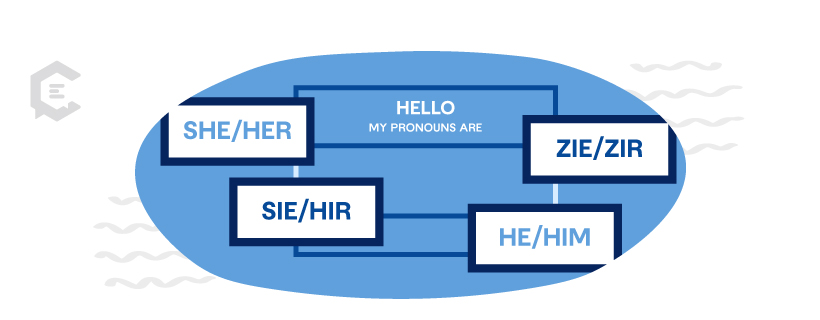In the last couple of years, both Instagram and LinkedIn rolled out updates to allow users to add their personal pronouns to their profiles.
This news was met with excitement across the platform, as many users saw it as a step towards inclusivity.
In recent years, public awareness of personal pronouns has become more and more common. They’re an important way to express gender identity, but the broadening of possibilities has led to some confusion and heated discussions about gender and grammar.
Learn how to use pronouns to make your writing more inclusive to all.

Personal pronouns are an expression of gender identity
Before we get into how to use pronouns, let’s go over a refresher on what they are.
They’re an expression of an individual’s gender identity, which is their internal, individual experience of gender. Gender identity and gender expression (the external presentation of gender) vary from person to person, and pronouns do too!
Just like gender identity is an individual experience, personal pronouns depend on the individual. If someone identifies as male, he may use masculine options, and the same is true for someone who identifies as female.
Someone who identifies as nonbinary or gender fluid may choose the gender-neutral they/them, or a variety of gendered and non-gendered pronouns. A few commonly used gender-neutral options are sie/hir and zie/zir.
The Center, an LGBT community center in New York City, reminds us that “it is important to keep in mind that a person’s pronouns are not exclusively linked to gender and may not match your perception of that individual.”
You cannot always tell someone’s pronouns by looking at them.
Why pronouns matter
It’s important to share your preferred pronouns, no matter your gender identity. Transgender, nonbinary, and gender-nonconforming individuals have been sharing their preferred choices for years, so why shouldn’t everyone?
If more cisgender people share their pronouns, it could help normalize discussions about gender and help others feel more comfortable discussing their preferences. This is true if you share them in daily conversation, in your social media profiles, or in your email signature.
Our attitudes and language become more inclusive if we all participate in these conversations about gender identity and expression.
Try this: “Hi, my name is ______, and I use (he/him) (they/them) (she/her) (zie/zir).”
Example: “Hi, my name is Cassie, and I use she/her.”
How to use pronouns: 2 inclusive examples
Whether on your social media account or in a blog post, knowing how to use pronouns is important.
Many people who identify outside the male/female gender binary have chosen to use they/them… and many people have argued against the use of singular they because it is “grammatically incorrect.”
But here’s the thing: Grammar and language evolve with usage. If we start using they/them in the singular, then guess what? They’re singular. Most style guides now accept singular they, which has actually been in use much longer than you might think.
Singular they just makes sense, and not only because it is more inclusive. They is the perfect choice when you’re unaware of an individual’s gender identity. It’s so much easier and less clunky than “he or she” and “his/her.”
Example: Someone left their jacket here.
Example: Anyone who doesn’t love that movie is out of their mind.
So think about adding your own pronouns to your email signature or social media profile, and don’t balk at using the singular they in your writing. Anything we can do to make our language and writing more inclusive is a good call.
Need help creating inclusive content for your target audience? Talk to a content specialist at ClearVoice to get started today.




